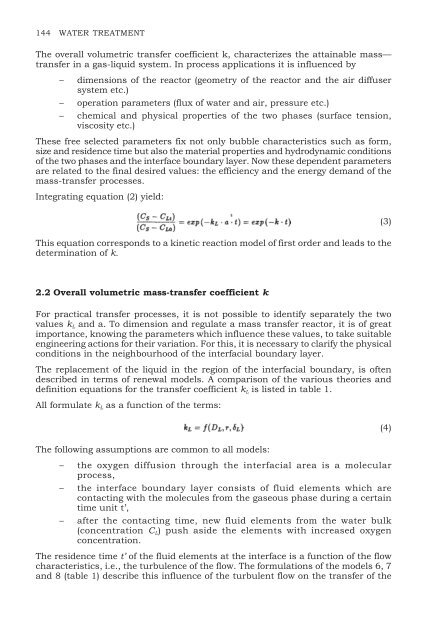Advances in Water Treatment and Enviromental Management
Advances in Water Treatment and Enviromental Management
Advances in Water Treatment and Enviromental Management
Create successful ePaper yourself
Turn your PDF publications into a flip-book with our unique Google optimized e-Paper software.
144 WATER TREATMENTThe overall volumetric transfer coefficient k, characterizes the atta<strong>in</strong>able mass—transfer <strong>in</strong> a gas-liquid system. In process applications it is <strong>in</strong>fluenced by– dimensions of the reactor (geometry of the reactor <strong>and</strong> the air diffusersystem etc.)– operation parameters (flux of water <strong>and</strong> air, pressure etc.)– chemical <strong>and</strong> physical properties of the two phases (surface tension,viscosity etc.)These free selected parameters fix not only bubble characteristics such as form,size <strong>and</strong> residence time but also the material properties <strong>and</strong> hydrodynamic conditionsof the two phases <strong>and</strong> the <strong>in</strong>terface boundary layer. Now these dependent parametersare related to the f<strong>in</strong>al desired values: the efficiency <strong>and</strong> the energy dem<strong>and</strong> of themass-transfer processes.Integrat<strong>in</strong>g equation (2) yield:This equation corresponds to a k<strong>in</strong>etic reaction model of first order <strong>and</strong> leads to thedeterm<strong>in</strong>ation of k.(3)2.2 Overall volumetric mass-transfer coefficient kFor practical transfer processes, it is not possible to identify separately the twovalues k L <strong>and</strong> a. To dimension <strong>and</strong> regulate a mass transfer reactor, it is of greatimportance, know<strong>in</strong>g the parameters which <strong>in</strong>fluence these values, to take suitableeng<strong>in</strong>eer<strong>in</strong>g actions for their variation. For this, it is necessary to clarify the physicalconditions <strong>in</strong> the neighbourhood of the <strong>in</strong>terfacial boundary layer.The replacement of the liquid <strong>in</strong> the region of the <strong>in</strong>terfacial boundary, is oftendescribed <strong>in</strong> terms of renewal models. A comparison of the various theories <strong>and</strong>def<strong>in</strong>ition equations for the transfer coefficient k L is listed <strong>in</strong> table 1.All formulate k L as a function of the terms:The follow<strong>in</strong>g assumptions are common to all models:– the oxygen diffusion through the <strong>in</strong>terfacial area is a molecularprocess,– the <strong>in</strong>terface boundary layer consists of fluid elements which arecontact<strong>in</strong>g with the molecules from the gaseous phase dur<strong>in</strong>g a certa<strong>in</strong>time unit t’,– after the contact<strong>in</strong>g time, new fluid elements from the water bulk(concentration C L ) push aside the elements with <strong>in</strong>creased oxygenconcentration.The residence time t’ of the fluid elements at the <strong>in</strong>terface is a function of the flowcharacteristics, i.e., the turbulence of the flow. The formulations of the models 6, 7<strong>and</strong> 8 (table 1) describe this <strong>in</strong>fluence of the turbulent flow on the transfer of the(4)
















